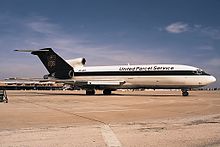Maersk Air
The A. P. Moller-Maersk Group's first investment in aviation was taken in 1937 when it bought a stake in Danish Air Lines, the flag carrier at the time.
Scandinavian Airlines System (SAS) was the flag carrier and had the sole right to conduct international scheduled services, and freight charters could only be carried out if the entire load had a single shipper and recipient.
[4] The airline aimed at ad hoc charter with aircraft in the 50-seat market, and perhaps securing the rights to fly regional scheduled flights to smaller domestic airports.
At the time Falck Air operated a fleet of two de Havilland Herons and two Hawker Siddeley HS 748 aircraft and a hangar at Copenhagen Airport, Kastrup.
[5] The Herons allowed Maersk to commence services from Copenhagen to Stauning Airport, a route taken over from Cimber Air.
SAS held a privilege to commence any route they wanted, but lacked regional airlines to serve the smaller airports.
[8] It was complicated by the establishment of alternative domestic airlines in Norway and Sweden, Braathens SAFE and Linjeflyg, respectively.
[11] Danish authorities, therefore, asked the three scheduled carriers, SAS, Maersk, and Cimber, to negotiate to see if they could reach an agreement.
And although the scheme did rise passenger numbers, it failed to improve Maersk Air's financial performance in the domestic market.
The first non-SAS international concession was in 1981 granted to Air Business from Esbjerg via Thistedt to Stavanger Airport, Sola in Norway, using an Embraer EMB-110 Bandeirante.
[28] Changes in European Community rules in 1984 allowed any carrier to operate intra-European routes, granted that they connected two regional airports.
[36] After a merger into Brymon European Airways and subsequent demerger, Maersk Air UK was founded on the foundations of BEA.
It operated a series of international and domestic services out of Birmingham Airport, initially with a fleet of three Jetstream 31 and three BAC One-Elevens.
[41] Maersk Air began services from Billund to Frankfurt in 1993,[44] and a year later it started flights from Copenhagen to Kristiansand.
[44] Unlike Cimber, Maersk initially declined to participate in SAS' frequent-flyer program, EuroBonus, which was founded in 1992.
[48] Maersk's success in Jutland was noticed by SAS, who in October 1996 opened its first service out of Billund, to Frankfurt.
In response, Maersk Air commenced services out of SAS' stronghold at Copenhagen Airport to Milan, Geneva and Stockholm the following year.
[52] With its eight daily round trips, Maersk Air only captured ten percent of the market on the Copenhagen–Stockholm route, losing money on it.
[53] With the 14 June 1998 opening of the Great Belt Fixed Link, car, coach and rail transport became faster between Jutland and Funen on the one hand, and Zealand on the other, cutting travel time by an hour.
[56] After the Oneworld negotiations failed, Maersk Air turned to SAS in an attempt to initiate a cooperation.
He also proposed competing head-on with SAS, as he believed that Maersk Air with the new strategy could operate with lower costs than the consortium.
[74] The airline adopted the slogan "fly as you like" and focused its route production on typical holiday destinations and cheap fares.
Inspired form the importance of crucial timing of purchase and sale of ships, Maersk Air made several advantages deals.
[83] Initially, Maersk and the other major Danish airlines had a common ground handling company, Copenhagen Air Services, at the eponymous airport.
Then Danair would set prices and sell tickets on the flights and the profits were paid out in relation to the ownership shares.
The flag carrier of Estonia was based at Tallinn Airport and flew a limited international network, using a combination of Boeing 737-500s and Fokker 50s.
It gradually built up a nationwide network of travel agency outlets, in Ålborg, Århus, Copenhagen, Esbjerg, Herning, Horsens, Odense and Skive.
Unisol—Denmark's third-largest inclusive tours travel agency—was placed under the industrial department in Maersk, while the airline reported directly to the executive administration.
[12] The following is a list of aircraft operated by Maersk Air, including its helicopter and corporate jet divisions.
A Bell 212 with registration OY-HMC crashed into the North Sea during a flight from Esbjerg Airport to an oil platform.





















